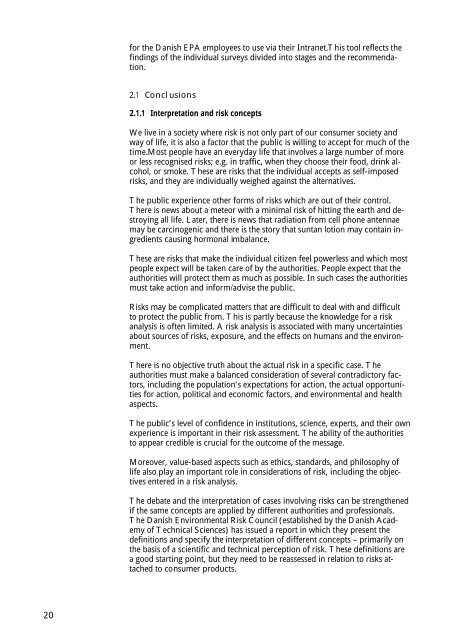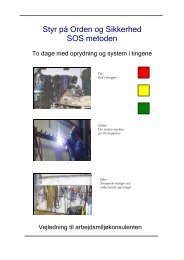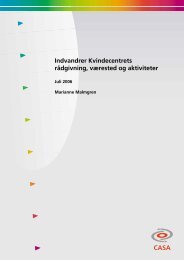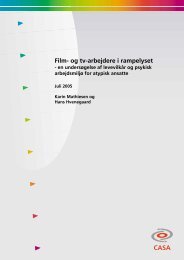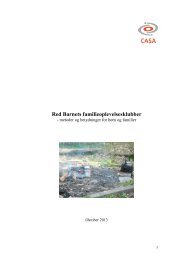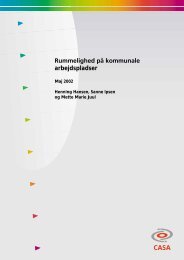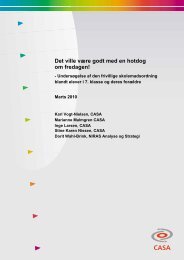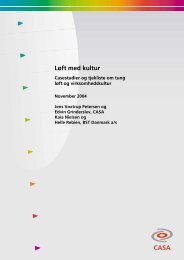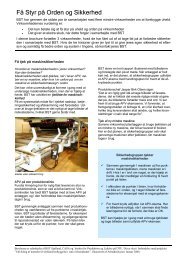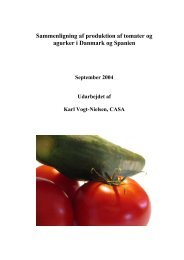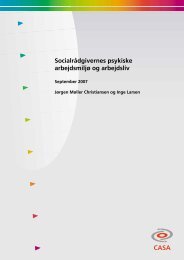Download rapport - Center for Alternativ Samfundsanalyse
Download rapport - Center for Alternativ Samfundsanalyse
Download rapport - Center for Alternativ Samfundsanalyse
You also want an ePaper? Increase the reach of your titles
YUMPU automatically turns print PDFs into web optimized ePapers that Google loves.
<strong>for</strong> the Danish EPA employees to use via their Intranet.This tool reflects thefindings of the individual surveys divided into stages and the recommendation.2.1 Conclusions2.1.1 Interpretation and risk conceptsWe live in a society where risk is not only part of our consumer society andway of life, it is also a factor that the public is willing to accept <strong>for</strong> much of thetime.Most people have an everyday life that involves a large number of moreor less recognised risks; e.g. in traffic, when they choose their food, drink alcohol,or smoke. These are risks that the individual accepts as self-imposedrisks, and they are individually weighed against the alternatives.The public experience other <strong>for</strong>ms of risks which are out of their control.There is news about a meteor with a minimal risk of hitting the earth and destroyingall life. Later, there is news that radiation from cell phone antennaemay be carcinogenic and there is the story that suntan lotion may contain ingredientscausing hormonal imbalance.These are risks that make the individual citizen feel powerless and which mostpeople expect will be taken care of by the authorities. People expect that theauthorities will protect them as much as possible. In such cases the authoritiesmust take action and in<strong>for</strong>m/advise the public.Risks may be complicated matters that are difficult to deal with and difficultto protect the public from. This is partly because the knowledge <strong>for</strong> a riskanalysis is often limited. A risk analysis is associated with many uncertaintiesabout sources of risks, exposure, and the effects on humans and the environment.There is no objective truth about the actual risk in a specific case. Theauthorities must make a balanced consideration of several contradictory factors,including the population’s expectations <strong>for</strong> action, the actual opportunities<strong>for</strong> action, political and economic factors, and environmental and healthaspects.The public’s level of confidence in institutions, science, experts, and their ownexperience is important in their risk assessment. The ability of the authoritiesto appear credible is crucial <strong>for</strong> the outcome of the message.Moreover, value-based aspects such as ethics, standards, and philosophy oflife also play an important role in considerations of risk, including the objectivesentered in a risk analysis.The debate and the interpretation of cases involving risks can be strengthenedif the same concepts are applied by different authorities and professionals.The Danish Environmental Risk Council (established by the Danish Academyof Technical Sciences) has issued a report in which they present thedefinitions and specify the interpretation of different concepts – primarily onthe basis of a scientific and technical perception of risk. These definitions area good starting point, but they need to be reassessed in relation to risks attachedto consumer products.20


